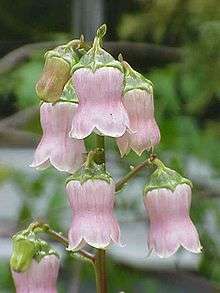Azorina
Azorina is a monotypic genus of flowering plants within the family Campanulaceae, whose sole species, the Azorina vidalii, is endemic to the Azores.[2] Its fragmented population is made up of fewer than 1000 mature plants limited to the coastlines of several of the islands.
| Azorina | |
|---|---|
 | |
| Scientific classification | |
| Kingdom: | Plantae |
| Clade: | Tracheophytes |
| Clade: | Angiosperms |
| Clade: | Eudicots |
| Clade: | Asterids |
| Order: | Asterales |
| Family: | Campanulaceae |
| Subfamily: | Campanuloideae |
| Genus: | Azorina Feer |
| Species: | A. vidalii |
| Binomial name | |
| Azorina vidalii (H.C.Watson) Feer | |
History
It was first harvested by Watson, along the coast of Santa Cruz on the Azorean island of Flores, during his botanical expedition in 1843.[3][4] It was initially designated Campanula vidalii by Watson and published in 1844.[3]
Its ecology has been presented in an inconsistent manner; it has been referred to as adapting to cracks in the sea cliffs, or to deposits, and in abrupt and sandy slopes.[3][5]
The Azorina vidalii was protected by the Bern Convention in 1992 (Annex I) and by the Habitats Directive 140/99 (Diário da República, Anexo 2B) considered a priority species in critical risk; it is an endangered species due to habitat degradation by invasive species, pollution, and development.[3][6]
The Azorina vidalii diverged from its ancestral descendants around 8.3±1.7 million years ago, associated with it first island of colonization, that of Santa Maria (Olesen et al., 2012), forming some 8-10 million years ago (Serralheiro & Madeira, 1993).[3] Carine et al. (2004) and Fernández-Palacios et al. (2011) also refer to the existence of submarine mounts, formerly immersed, that functioned as stepping-stones from the continent.[3] At the same time, the Azorina vidalii was not vulnerable to the rise in temperature and prefers the zones along the coast to propagate.[3]
References
Notes
- Bilz, M. (2013), "Azorina vidalii", IUCN, IUCN Red List of Threatened Species, retrieved 21 August 2013
- "Azorina". Germplasm Resources Information Network (GRIN). Agricultural Research Service (ARS), United States Department of Agriculture (USDA). Retrieved 21 January 2018.
- Rúben Coelho (2014), p.17
- Watson (1844)
- Sjögren (1984)
- M. Bliz (2011)
Sources
- Coelho, Rúben (1 October 2014), Plano de Gestão e Conservação de Azorina vidalii (Wats.) Feer (in Portuguese), Angra do Heroísmo: University of the Azores
| Wikimedia Commons has media related to Azorina. |
| Wikispecies has information related to Azorina |
